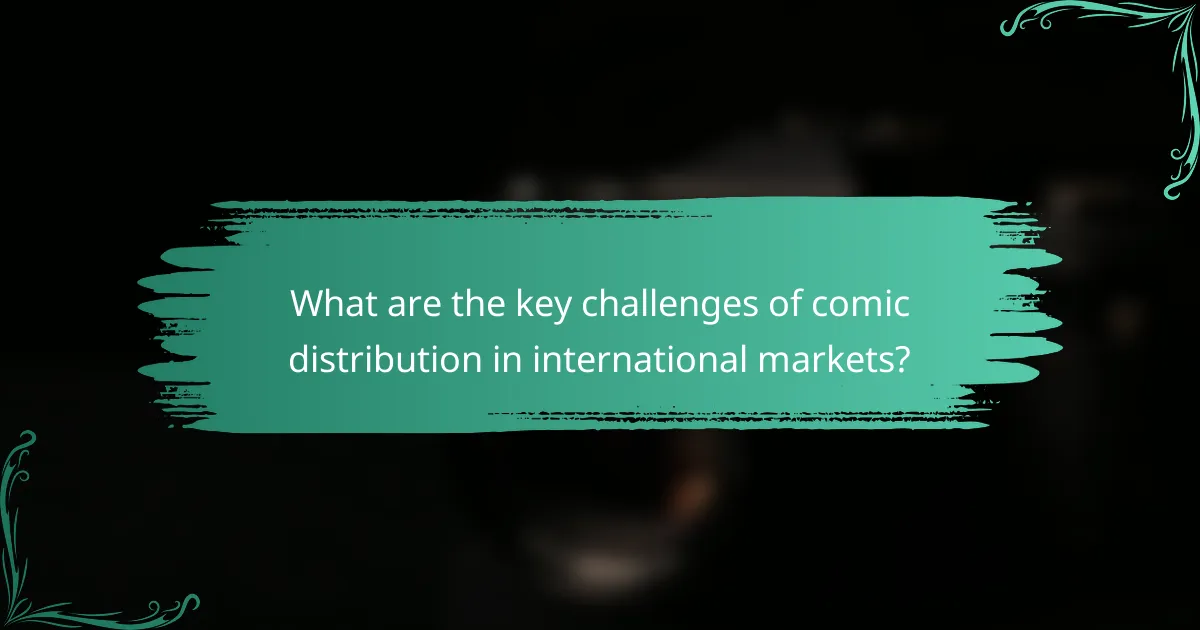Comic distribution in international markets presents unique challenges, including navigating complex regulations, managing logistical intricacies, and adapting to diverse audience preferences. Understanding the regulatory landscape is crucial for ensuring compliance and protecting intellectual property, while effective logistics planning is essential for timely delivery and accessibility. Addressing these factors is vital for the successful introduction and sustained popularity of comic titles across different cultures.

What are the key challenges of comic distribution in international markets?
The key challenges of comic distribution in international markets include navigating regulatory hurdles, managing logistical complexities, and understanding cultural audience differences. Each of these factors can significantly impact the success of comic titles in foreign territories.
Regulatory hurdles
Regulatory hurdles can vary widely across countries, affecting how comics are distributed and marketed. Import restrictions, copyright laws, and censorship regulations must be thoroughly understood to avoid legal issues.
For example, some countries may require specific content ratings or may ban certain themes altogether. It is essential to conduct research on local laws and possibly consult legal experts to ensure compliance.
Logistical complexities
Logistical complexities in international comic distribution involve shipping, warehousing, and inventory management. Different countries may have varying shipping costs, customs procedures, and delivery times that can complicate the distribution process.
Utilizing local distributors can help mitigate these challenges by leveraging their knowledge of the market and established networks. Additionally, considering digital distribution can reduce some logistical burdens, although it comes with its own set of challenges.
Cultural audience differences
Cultural audience differences play a crucial role in how comics are received in international markets. Preferences for art styles, storytelling techniques, and themes can vary significantly, affecting sales and engagement.
Understanding local tastes is vital for successful distribution. Conducting market research or collaborating with local creators can provide insights into what resonates with different audiences, allowing for tailored marketing strategies and content adjustments.

How do regulations impact comic distribution globally?
Regulations significantly influence comic distribution by dictating what can be imported or exported, as well as protecting intellectual property rights. Understanding these regulations is essential for navigating international markets effectively.
Import/export restrictions
Import and export restrictions vary widely by country and can affect the availability of comics in international markets. Some nations impose tariffs or quotas on imported goods, which can increase costs and limit the volume of comics that can be distributed.
For example, countries in the European Union may have specific import duties that apply to printed materials, while others might require special licenses for distribution. It’s crucial for comic distributors to research local regulations to avoid penalties and ensure compliance.
Copyright and intellectual property laws
Copyright and intellectual property laws play a vital role in protecting the rights of comic creators and publishers. These laws vary by jurisdiction, impacting how comics can be reproduced, distributed, and sold internationally.
In the United States, for instance, copyright protection is automatic upon creation, while in some countries, registration may be required for enforcement. Distributors should be aware of the local laws to safeguard their content and avoid infringement issues.

What logistics are involved in international comic distribution?
International comic distribution involves several logistics, including shipping, handling, warehousing, and inventory management. Each aspect requires careful planning to navigate regulations and ensure timely delivery to diverse audiences.
Shipping and handling requirements
Shipping comics internationally requires compliance with various regulations, including customs documentation and import/export laws. It’s essential to choose reliable carriers familiar with international shipping to avoid delays and additional costs.
Consider the shipping methods available, such as air freight for faster delivery or sea freight for cost savings. Weigh the trade-offs between speed and expense, as air shipping can be significantly more expensive than sea options.
Warehousing and inventory management
Effective warehousing is crucial for managing comic inventory across different countries. Establishing local warehouses can reduce shipping times and costs, but it also requires investment in local regulations and operational management.
Implement inventory management systems to track stock levels and sales trends. This helps in making informed decisions about restocking and can prevent overstocking or stockouts, which can be costly in international markets.

How can publishers adapt to diverse international audiences?
Publishers can adapt to diverse international audiences by employing tailored localization strategies and conducting thorough market research. Understanding cultural nuances and preferences is essential for creating content that resonates with readers in different regions.
Localization strategies
Localization involves more than just translating text; it requires adapting content to fit cultural contexts. This includes adjusting humor, references, and even visual elements to align with local tastes. For instance, a comic that works well in the U.S. may need significant changes to appeal to audiences in Japan or Brazil.
Publishers should consider hiring local experts or consultants who understand the target market. This can help avoid common pitfalls, such as using idioms that do not translate well or failing to recognize local sensitivities. Additionally, utilizing local artists can enhance authenticity and relatability.
Market research and audience analysis
Conducting market research is crucial for understanding the preferences and behaviors of international audiences. This can include surveys, focus groups, and analyzing sales data to identify trends. For example, comics featuring strong female protagonists may perform better in certain markets, while others might prefer action-oriented narratives.
Audience analysis should also consider demographics, such as age, gender, and socio-economic status. Tailoring content to specific segments can increase engagement and sales. Publishers can use tools like social media analytics to gauge audience interests and feedback, ensuring their offerings align with local expectations.

What are the best practices for navigating international comic distribution?
To successfully navigate international comic distribution, it is essential to understand local regulations, establish strong partnerships, and leverage digital platforms. These strategies can help overcome logistical challenges and connect with diverse audiences effectively.
Partnering with local distributors
Partnering with local distributors can significantly enhance your reach in international markets. Local distributors have established networks and a deep understanding of regional preferences, which can facilitate smoother entry into new territories.
When selecting a distributor, consider their reputation, market knowledge, and distribution channels. For example, a distributor in Germany may have insights into popular genres among German readers, allowing you to tailor your offerings accordingly.
Be mindful of potential pitfalls, such as misaligned goals or communication barriers. Establish clear agreements that outline responsibilities, revenue sharing, and marketing strategies to ensure a successful partnership.
Utilizing digital distribution platforms
Digital distribution platforms offer a flexible and cost-effective way to reach international audiences. Services like ComiXology, Webtoon, and Tapas allow creators to publish and distribute comics globally without the constraints of traditional print logistics.
When choosing a platform, consider factors such as audience demographics, platform fees, and ease of use. For instance, Webtoon may be more popular in South Korea, while ComiXology has a strong presence in North America. Tailor your content to fit the platform’s audience for better engagement.
However, do not overlook the importance of marketing your digital comics. Utilize social media, email newsletters, and online communities to promote your work and drive traffic to your digital storefronts. This proactive approach can help you build a loyal international readership.

What role do emerging technologies play in comic distribution?
Emerging technologies significantly enhance comic distribution by improving efficiency, security, and audience engagement. Innovations like blockchain and augmented reality offer unique solutions to traditional challenges in the comic industry.
Blockchain for copyright protection
Blockchain technology provides a decentralized method for securing copyright ownership of comic works. By creating an immutable ledger, creators can register their comics, ensuring that their intellectual property is protected against unauthorized use.
Using blockchain, comic publishers can also streamline royalty payments, allowing for transparent tracking of sales and distribution. This can lead to faster payments and reduced disputes over earnings, which is particularly beneficial in international markets where regulations may vary.
Augmented reality in marketing
Augmented reality (AR) enhances comic marketing by creating interactive experiences that engage readers. For example, AR can bring comic panels to life through mobile apps, allowing users to see animations or additional content when they scan pages with their devices.
Implementing AR requires investment in technology and content development, but it can significantly boost audience interest and sales. Publishers should consider collaborating with tech firms to create compelling AR experiences that resonate with their target demographics, especially in markets where digital engagement is high.

How can data analytics improve comic distribution strategies?
Data analytics can significantly enhance comic distribution strategies by providing insights into audience preferences, sales patterns, and market trends. By leveraging data, publishers can make informed decisions that optimize their distribution channels and improve overall engagement.
Audience engagement metrics
Understanding audience engagement metrics is crucial for tailoring comic distribution. Metrics such as social media interactions, website traffic, and reader feedback can reveal what content resonates with specific demographics. For example, tracking which comic series generates the most shares or comments can guide future publishing decisions.
Utilizing tools like Google Analytics or social media insights can help publishers monitor these metrics effectively. Regularly reviewing engagement data allows for timely adjustments to marketing strategies, ensuring that comics reach the right audiences at the right times.
Sales forecasting and trend analysis
Sales forecasting and trend analysis enable comic publishers to predict future sales based on historical data. By analyzing past sales figures, seasonal trends, and market shifts, publishers can better allocate resources and plan inventory. For instance, if a particular genre shows consistent growth, increasing stock in that area can maximize profits.
Employing predictive analytics tools can streamline this process. These tools can identify patterns and suggest optimal pricing strategies, helping to avoid overstocking or stockouts. Regularly updating forecasts based on new data ensures that distribution strategies remain agile and responsive to market changes.
